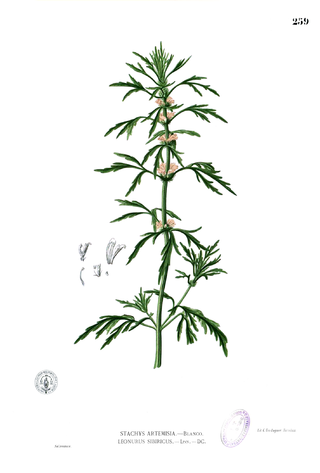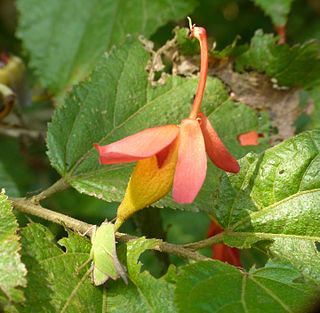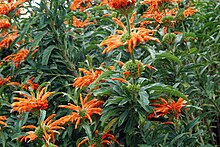
Abrus precatorius, commonly known as jequirity bean or rosary pea, is a herbaceous flowering plant in the bean family Fabaceae. It is a slender, perennial climber with long, pinnate-leafleted leaves that twines around trees, shrubs, and hedges.

Leonotis is a genus of flowering plants in the family Lamiaceae. One species, Leonotis nepetifolia, is native to tropical Africa and southern India. It is naturalized throughout most of the tropics. The other species are endemic to southern + eastern Africa.

Stachys is a genus of plants, one of the largest in the mint family Lamiaceae. Estimates of the number of species vary from about 300, to about 450. Stachys is in the subfamily Lamioideae and its type species is Stachys sylvatica. The precise extent of the genus and its relationship to other genera in the subfamily are poorly known.

Leonurus cardiaca, known as motherwort, is an herbaceous perennial plant in the mint family, Lamiaceae. Other common names include throw-wort, lion's ear, and lion's tail. Lion's tail is also a common name for Leonotis leonurus, and lion's ear, a common name for Leonotis nepetifolia. Originally from Central Asia and southeastern Europe, it is now found worldwide, spread largely due to its use as a herbal remedy.

Vitex is a genus of flowering plants in the sage family Lamiaceae. It has about 250 species. Common names include chaste tree or chastetree, traditionally referring to V. agnus-castus, but often applied to other species, as well.

Leonotis nepetifolia,, is a species of plant in the genus Leonotis and the family Lamiaceae (mint), It is native to tropical Africa and southern India. It can also be found growing abundantly in much of Latin America, the West Indies, and the Southeastern United States. It grows to a height of 3 metres and has whorls of striking lipped flowers, that are most commonly orange, but can vary to red, white, and purple. It has drooping dark green, very soft serrated leaves that can grow up to 10 centimetres (4 in) wide. Sunbirds and ants are attracted to the flowers. It has been found growing on roadsides, rubbish heaps or waste land.

Prunella vulgaris, the common self-heal, heal-all, woundwort, heart-of-the-earth, carpenter's herb, brownwort or blue curls, is an herbaceous plant in the mint family Lamiaceae.

The copper sunbird is a species of passerine bird in the family Nectariniidae. It is native to tropical Africa, its range extending from Senegal and Guinea in the west to South Sudan and Kenya in the east, and southwards to Angola, Zambia, Zimbabwe and Mozambique.

Leonurus japonicus, commonly called oriental motherwort or Chinese motherwort, is a herbaceous flowering plant native to Asia, including Korea and Japan, and China to Cambodia.

Leonurine is a pseudoalkaloid that has been isolated from Leonotis leonurus, Leonotis nepetifolia, Leonurus japonicus, Leonurus cardiaca (motherwort), Leonurus sibiricus, as well as other plants of family Lamiaceae. Leonurine is easily extracted into water.

Vernonia amygdalina, a member of the daisy family, is a small to medium-sized shrub that grows in tropical Africa. V. amygdalina typically grows to a height of 2–5 m (6.6–16.4 ft). The leaves are elliptical and up to 20 cm (7.9 in) long. Its bark is rough.

Docosatetraenoylethanolamide (DEA) (Adrenoyl-ethanolamide) (Adrenoyl-EA) is an endogenous ethanolamide that has been shown to act on the cannabinoid (CB1) receptor. DEA is similar in structure to anandamide (AEA, a recognized endogenous ligand for the CB1 receptor), containing docosatetraenoic acid in place of arachidonic acid. While DEA has been shown to bind to the CB1 receptor with similar potency and efficacy as AEA, its role as a cannabinergic neurotransmitter is not well understood.

Trema orientale is a species of flowering tree in the hemp family, Cannabaceae. It is known by many common names, including charcoal-tree, Indian charcoal-tree, pigeon wood, Oriental trema, and in Hawaii, where it has become naturalized, gunpowder tree, or nalita. It has a near universal distribution in tropical and warm temperate parts of the Old World, with a range extending from South Africa, through the Middle East, the Indian subcontinent and southern China to Southeast Asia and Australia.

Ziziphus oenopolia, commonly known as the jackal jujube, small-fruited jujube or wild jujube, is a flowering plant with a broad distribution through tropical and subtropical Asia and Australasia. In India, it is mostly found in the deciduous forests of the southern part of the country.

Ichnocarpus frutescens is a species of flowering plant in the dogbane family Apocynaceae, known by the English common name black creeper. It is native to much of China, India, Southeast Asia, and northern Australia.

Helicteres isora, sometimes called the Indian screw tree, is a small tree or large shrub found in southern Asia and northern Oceania. It is usually assigned to the family Malvaceae, but it is sometimes assigned to the family Sterculiaceae. The red flowers are pollinated mainly by sunbirds, butterflies, and Hymenoptera. In the 19th century fibers from the bark were used to make rope and sacks, although nowadays the tree is harvested for the fruits and roots which are used in folk medicine.

Lobelia laxiflora is a species of flowering plant in the family Campanulaceae. It is native to the Americas, where it is distributed in South, Central, and North America as far north as Arizona in the United States. It is known by several English-language common names, including Mexican lobelia, Sierra Madre lobelia, Mexican cardinalflower, looseflowers lobelia, and drooping lobelia. In Spanish and Nahuatl it is known as aretitos, acaxóchitl, and chilpanxóchitl. It has gained the Royal Horticultural Society's Award of Garden Merit as an ornamental.

Leonotis ocymifolia, occasionally referred to as the minaret flower, is a flowering plant of the mint family, Lamiaceae. The plant is used in Ethiopian folk medicine and found in Eastern Africa spanning from Sudan to South Africa. The plant is reasonably drought-resistant and wind tolerant. Unlike the similar Leonotus leonuris, in the ocymifolia, the tubular flowers are bolder and larger.

Dagga is a word used in certain areas of Southern Africa to describe cannabis. The term, dating to the 1660s, derives from the word dacha in the Khoekhoe language used to describe the plant as well as various species of Leonotis. The leaves of specifically the Leonotis leonurus resemble the cannabis leaf and is known locally as wild dagga. The word has been spelled many different ways over time as various groups of people began using the term and some examples of these are: daggha, dacha, dacka, dagha, tagga, dachka, daga. According to the Oxford Dictionary, dagga was also used by the Khoekhoe to describe the sensation of intoxication.

Bothriocline longipes is a woody perennial herb or shrub capable of reaching three meters tall. It is part of the family Asteraceae.





















